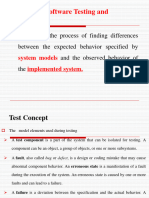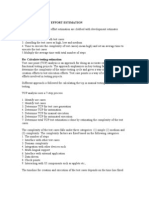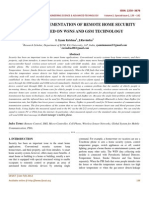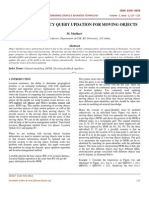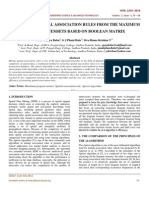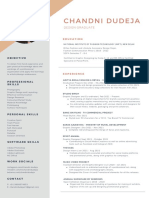Ieb: Integrated Testing Environment On Loop Boundaries: R. Nagendra Babu, B.Chaitanya Krishna, Ch. V.Phani Krishna
Ieb: Integrated Testing Environment On Loop Boundaries: R. Nagendra Babu, B.Chaitanya Krishna, Ch. V.Phani Krishna
Uploaded by
Ijesat JournalCopyright:
Available Formats
Ieb: Integrated Testing Environment On Loop Boundaries: R. Nagendra Babu, B.Chaitanya Krishna, Ch. V.Phani Krishna
Ieb: Integrated Testing Environment On Loop Boundaries: R. Nagendra Babu, B.Chaitanya Krishna, Ch. V.Phani Krishna
Uploaded by
Ijesat JournalOriginal Title
Copyright
Available Formats
Share this document
Did you find this document useful?
Is this content inappropriate?
Copyright:
Available Formats
Ieb: Integrated Testing Environment On Loop Boundaries: R. Nagendra Babu, B.Chaitanya Krishna, Ch. V.Phani Krishna
Ieb: Integrated Testing Environment On Loop Boundaries: R. Nagendra Babu, B.Chaitanya Krishna, Ch. V.Phani Krishna
Uploaded by
Ijesat JournalCopyright:
Available Formats
R. NAGENDRA BABU * et al.
[IJESAT] INTERNATIONAL JOURNAL OF ENGINEERING SCIENCE & ADVANCED TECHNOLOGY
ISSN: 22503676
Volume - 2, Special Issue - 1, 88 92
IEB: INTEGRATED TESTING ENVIRONMENT ON LOOP BOUNDARIES
R. Nagendra Babu1, B.Chaitanya Krishna2, Ch. V.Phani Krishna3
2
M.Tech (CSE), K L University, Andhra Pradesh, India, nrajaboina@yahoo.com Assistant Professor, CSE, K L University, Andhra Pradesh,India,chaitu2502@gmail.com 3 Associate Professor, CSE, K L University, Andhra Pradesh,India,phanik16@yahoo.co.in
Abstract
Specifications of unit behavior are usually informal and are often incomplete or ambiguous, leading to the development of overly general or incorrect unit tests. System Testing is executing every unit of code of entire system. But it mainly depends on unit test cases. If any test case has errors then the result will be propagated until system testing. To overcome this, test cases should be efficient in each phase. Some test cases execute on components perfectly, but when modules are integrated then those set of test cases will not be sufficient. Redundant test case execution or insufficient testing will be happened. In our proposed framework, we eliminate redundant test cases from execution sequence and we can identify more test points. It further reduces time by concentrating on loops. There is no need to check all values within loop boundaries. Our proposed System is proved as more efficient compared to existing approaches. Test cost, testing time will be reduced to enhance Integration Testing.
Index Terms:Module Testing, Reducing Test Cost, Module testing. --------------------------------------------------------------------- *** ---------------------------------------------------------------------1. INTRODUCTION
Test Engineers design individual unit test cases to test components. Single component will be executed perfectly but if they combined with modules there may be chance for time taking. Unit Test cases involves test case for particular variable or GUI component like button, text box and checkbox. This component will be worked w.r.to unit test case. But each component will have pages of logic to interact. It will work in a different manner in different modules. Throughout their lifetimes, software systems undergo numerous changes. Such changes are essential to accommodate new technologies and user needs, but they can also adversely impact the quality and reliability of the software. To address this problem, software test engineers perform module testing to revalidate software following modifications. Integration testing is important, but it is also expensive. For example, one of the authors of this article works with an industrial collaborator who has, for a software system of only about 20,000 lines of code, a test suite that requires seven CPU weeks to run. A second industrial collaborator, for a much larger system, runs tests continuously, in a rolling test cycle requiring over 30 days. Even much shorter module test cycles can be expensive, however, when they require human effort to set up for, execute, or validate outputs of tests. To reduce the costs associated with integration testing researchers have proposed several techniques. But they concentrate on unit test cases which are time taking. mainly
Generally unit test cases are completely executed one without fail. But executing loops involves more time compared to components. We will perform our testing on software in 4 approaches. Unit testing, component testing, Integration testing and finally system testing are 4 approaches. Every system engineer starts with unit testing. Unit testing involves testing one component or option in all cases without fail. If loop is to be checked then it will be checked for all values. Satisfying precondition and post condition is also tested. While system tests are an essential component of all practical software validation methods, they do have several disadvantages. They can be expensive to execute; for large systems, days or weeks, and considerable human effort may be needed for running a thorough suite of module tests [8]. In addition, even very thorough system testing may fail to exercise the full range of behavior implemented by a systems particular units; thus, system testing cannot be viewed as an effective replacement for unit testing. Finally, fault isolation and repair during system testing can be significantly more expensive than during unit testing. Thus System testing is not direct replacement for unit testing. Developing effective suites of unit test cases presents a number of challenges. Specifications of unit behavior are usually informal and are often incomplete or ambiguous,
IJESAT | Jan-Feb 2012
Available online @ http://www.ijesat.org 88
R. NAGENDRA BABU * et al. [IJESAT] INTERNATIONAL JOURNAL OF ENGINEERING SCIENCE & ADVANCED TECHNOLOGY leading to the development of overly general or incorrect unit tests. Furthermore, such specifications may evolve independently of implementations requiring additional maintenance of unit tests even if implementations remain unchanged. Testers may find it difficult to imagine sets of unit input values that exercise the full range of unit behavior and thereby fail to exercise the different ways in which the unit will be used as a part of a system. An alternative approach to unit test development, which does not rely on specifications, is based on the analysis of a units implementation. Testers developing unit tests in this way may focus, for example, on achieving coverage-adequacy criteria in testing the target units code. Such tests, however, are inherently susceptible to errors of omission with respect to specified unit behavior and may thereby miss certain faults. Finally, unit testing requires the development of test harnesses or the setup of a testing framework to make the units executable in isolation. Software engineers also develop system tests, usually based on documents that are available for most software systems that describe the systems functionality from the users perspective, for example, requirement documents and users manuals. This makes system tests appropriate for determining the readiness of a system for release or its acceptability to customers. Additional benefits accrue from testing systemlevel behaviors directly. First, system tests can be developed without an intimate knowledge of the system internals, which reduces the level of expertise required by test developers and makes tests less sensitive to implementation-level changes that are behavior preserving. Second, system tests may expose faults that unit tests do not, for example, faults that emerge only when multiple units are integrated and jointly utilized. Finally, since they involve executing the entire system, no individual harnesses need to be constructed.
ISSN: 22503676
Volume - 2, Special Issue - 1, 88 92
large programs with sequences of versions drawn from the field, containing various modifications. The focus of this experiment, however, was strictly test suite composition: the independent variable manipulated was the number of individual test inputs constituting each test case in the suite. The work did not consider or measure change attributes, and no attempt was made to correlate attributes of change with technique performance. Two previous studies are more closely related to this one. To investigate the impact of integrated testing frequency on test selection, Kim et al. [13] varied the number of changes made in versions of several programs, and measured the impact of this number on test selection and fault detection effectiveness. Elbaum et al. [8] performed experiments exploring characteristics of program structure, test suite composition, and changes on prioritization, and identified several metrics characterizing these attributes that correlate with prioritization effectiveness. These studies differ from the work reported in this article in several ways. First, neither of them specifically examined how the type and magnitude of changes, their distribution throughout the program, and their relation to test coverage patterns, affect the cost-effectiveness of integrated test selection techniques. Second, although [8] did consider various change characteristics with respect to test case prioritization, it focused on identifying such characteristics, and not on measuring their effects. Moreover, both studies were performed on a set of small programs (an existing suite of seven programs of less than 1K LOC, and one of 6.2K LOC), whose modifications consisted solely of one- or two-line seeded faults, singly or in combination. This constrains the generality of the results, and leaves unresolved questions as to the scalability and applicability of the relationships determined. ATPG (acronym for both Automatic Test Pattern Generation and Automatic Test Pattern Generator) is an electronic design automation method/technology used to find an input (or test) sequence that, when applied to a digital circuit, enables testers to distinguish between the correct circuit behavior and the faulty circuit behavior caused by defects. The generated patterns are used to test semiconductor devices after manufacture, and in some cases to assist with determining the cause of failure (failure analysis.[1]) the effectiveness of ATPG is measured by the amount of modeled defects, or fault models, that are detected and the number of generated patterns. These metrics generally indicate test quality (higher with more fault detections) and test application time (higher with more patterns). ATPG efficiency is another important
2. RELATED WORK
Initially, most studies of integrated test selection and test case prioritization focused on the cost-effectiveness of individual techniques, the estimation of a technique's performance, or comparisons of techniques [3, 7, 10, and 12]. These studies showed that various techniques could be cost-effective, and suggested tradeoffs among them. However, the studies also revealed wide variances in performance, and attributed these two factors involving the programs under test, the test suites used to test them, and the types of modifications made to the programs. More recent studies have begun to examine these factors. We [10] studied the effects of test case granularity on integrated testing techniques, varying the composition of test suites and examining the effects on cost-effectiveness of test selection and prioritization. This experiment was performed on two
IJESAT | Jan-Feb 2012
Available online @ http://www.ijesat.org 89
R. NAGENDRA BABU * et al. [IJESAT] INTERNATIONAL JOURNAL OF ENGINEERING SCIENCE & ADVANCED TECHNOLOGY consideration. It is influenced by the fault model under consideration, the type of circuit under test (full scan, synchronous sequential, or asynchronous sequential), the level of abstraction used to represent the circuit under test (gate, register-transistor. A defect is an error introduced into a device during the manufacturing process. A fault model is a mathematical description of how a defect alters design behavior. A fault is said to be detected by a test pattern if, when applying the pattern to the design, any logic value observed at one or more of the circuit's primary outputs differs between the original design and the design with the fault. The ATPG process for a targeted fault consists of two phases: fault activation and fault propagation. Fault activation establishes a signal value at the fault model site that is opposite of the value produced by the fault model. Fault propagation moves the resulting signal value, or fault effect, forward by sensitizing a path from the fault site to a primary output. ATPG can fail to find a test for a particular fault in at least two cases. First, the fault may be intrinsically undetectable, such that no patterns exist that can detect that particular fault. The classic example of this is a redundant circuit, designed so that no single fault causes the output to change. In such a circuit, any single fault will be inherently undetectable. Second, it is possible that a pattern(s) exist, but the algorithm cannot find it. Since the ATPG problem is NP-complete (by reduction from the Boolean satisfiability problem) there will be cases where patterns exist, but ATPG gives up since it will take an incredibly long time to find them In the past several decades, the most popular fault model used in practice is the single stuck-at fault model. In this model, one of the signal lines in a circuit is assumed to be stuck at a fixed logic value, regardless of what inputs are supplied to the circuit. Hence, if a circuit has n signal lines, there are potentially 2n stuck-at faults defined on the circuit, of which some can be viewed as being equivalent to others. The stuckat fault model is a logical fault model because no delay information is associated with the fault definition. It is also called a permanent fault model because the faulty effect is assumed to be permanent, in contrast to intermittent faults which occur (seemingly) at random and transient faults which occur sporadically, perhaps depending on operating conditions (e.g. temperature, power supply voltage) or on the data values (high or low voltage states) on surrounding signal lines. The single stuck-at fault model is structural because it is defined based on a structural gate-level circuit model.
ISSN: 22503676
Volume - 2, Special Issue - 1, 88 92
A pattern set with 100% stuck-at fault coverage consists of tests to detect every possible stuck-at fault in a circuit. 100% stuck-at fault coverage does not necessarily guarantee high quality, since faults of many other kinds -- such as bridging faults, opens faults, and transition (a delay) faults -- often occur.
3. FRAMEWORK OF IEB
IEB mainly concentrates on loops and their test cases. System engineer will design unit test cases for loops. These test cases will be executed perfectly in the part of unit testing. Above level on unit testing is module testing. This tested component will be tested under module testing again. The results will be saved. But again testing this component with respect to Integrated Testing is more costly one. Our approach has two steps 1. 2. Select loop for component Design test case
In first step select loop of component with boundaries like following one. for (i=9; i<=18; i++) or i:=9; For (; ;) { If(i<=18) break; i++; }
Public class Book Printer{ Public int index = 0; Public String current; Public int length; Public void print Book(){ While(index< length) { Current=read(); incIndex();
IJESAT | Jan-Feb 2012
Available online @ http://www.ijesat.org 90
R. NAGENDRA BABU * et al. [IJESAT] INTERNATIONAL JOURNAL OF ENGINEERING SCIENCE & ADVANCED TECHNOLOGY } } In second step following algorithm is applied to reduce time and cost over unit testing. Already entire values of loop will be checked in unit testing. So checking entire values in integrated testing may lead to time consuming. Steps: 1) Design test case for loop Test Case ID Precondition Post Condition Expected Result Actual Result Comparison Modifications
ISSN: 22503676
Volume - 2, Special Issue - 1, 88 92
If (,) are range values for loop. Integration testing involves (--, ++) also. For testing ranges will be (-,,++) and for testing ranges will be (--,, ++). Testing these random values will be sufficient in integrated testing as it is already tested in unit testing.
4. CONCLUSION
This frame work reduces time while integrated testing over existing approaches. Minimization produced the smallest and the least effective test suites. Although fault detection is obviously important, there are cases where testing is very expensive. In these cases minimization may be cost-effective. For example, change size does not seem to be the predominant factor in determining the cost-effectiveness of techniques. Instead, the distribution of changes across functions and files, and whether the test cases reached those changes, seem to be the main contributors to the variation observed across all programs. A simple lines-of-code mentality used to evaluate prospective modifications will not produce effective results. Integration testing mainly concentrates on boundaries rather than all values. So that test cost will be reduced up to some extent over unit testing.
REFERENCES
[1] Carving and Replaying Differential Unit Test Cases from System Test Cases- Sebastian Elbaum, Hui Nee Chiny, Matthew B. Dwyerz, Matthew Jorde- January/February2009. [2]JTest,Jtest Product Overview, http://www.parasoft.com/jsp/ products/home.jsp?product=Jtest, Oct. 2005. [3] C. Pacheco and M.D. Ernst, Eclat: Automatic Generation and Classification of Test Inputs, Proc. 19th European Conf. Object- Oriented Programming, pp. 504-527, July 2005. [4] N. Juristo, A. M. Moreno, and S. Vegas. Reviewing 25 years of testing technique experiments. Empirical Software Engineering: An International Journal, 9(1), March 2004. [5] D. Saff and M.D. Ernst, An Experimental Evaluation of Continuous Testing During Development, Proc. Intl Symp. Software Testing and Analysis, pp. 76-85, July 2004. [6] T. Xie and D. Notkin. Macro and micro perspectives on strategic software quality assurance in resource constrained environments. In Proceedings of EDSER-4, May 2002. [7] J. Kim and A. Porter. A history-based test prioritization technique for regression testing in resource constrained environments. In Intl. Conf. Softw. Eng., May 2002.
2) Consider pre values and its range 3) Range for =(++ + -- )/2 4) Range for =( ++ + -- )/2 ((--, , ++), (--, , ++)) 5) Consider post values and its range 6) Consider random values to execute Return Rand () 7) Apply changes before integration testing Example: for(i=9;i<=18;i++) {.. .. if( i==11) ..... if(i==15) .. } 1) check this loop for 7,8,9 (pre condition values) 2) check this loop for 17,18,19 (post condition values) 3) check loop for 11,15 and random (main conditions values)
IJESAT | Jan-Feb 2012
Available online @ http://www.ijesat.org 91
R. NAGENDRA BABU * et al. [IJESAT] INTERNATIONAL JOURNAL OF ENGINEERING SCIENCE & ADVANCED TECHNOLOGY [8] B. Kitchenham, S. Pfleeger, L. Pickard, P. Jones, D. Hoaglin, K. Emam, and J. Rosenberg. Preliminary guidelines for empirical research in software engineering. IEEE Transactions on Software Engineering, 28(8):721734, August 2002. [9] S. Elbaum, D. Gable, and G. Rothermel. Understanding and measuring the sources of variation in the prioritization of regression test suites. In Proceedings of the International Software Metrics Symposium, pages 169{179, Apr. 2001. [10] B. Weide, Modular Regression Testing: Connections to Component- Based Software, Proc. Fourth ICSE Workshop Component- Based Software Engineering, pp. 82-91, May 2001. [11] J. Bible, G. Rothermel, and D. Rosenblum. Coarse- and fine-grained safe regression test selection. ACM Transactions on Software Engineering and Methodologies, 10(2):149{183, Apr. 2001. [12] T. Ball. On the limit of control ow analysis for regression test selection. In Proceedings of the ACM International Symposium on Software Testing and Analysis, pages 134{142, Mar. 1998 [13] Y. Chen, D. Rosenblum, and K. Vo. TestTube: A system for selective regression testing. In Proceedings of the 16th International Conference on Software Engineering, pages 211{220, May 1994. [14] M. Balcer, W. Hasling, and T. Ostrand. Automatic generation of test scripts from formal test specifications. In Proceedings of the 3rd ACM Symposium on Software Testing, Analysis, and Verification, pages 210{218, Dec. 1989. [15] J. Bach, Useful Features of a Test Automation System (Part III), Testing Techniques Newsletter, Oct. 1996. [16] K. Beck, Extreme Programming Explained: Embrace Change, first ed. Addison-Wesley Professional, Oct. 1999. [17] K. Beck, Test Driven Development: By Example. Addison Wesley Longman, Nov. 2002. [18] R. Binder, Testing Object-Oriented Systems: Models, Patterns, and Tools, chapter 18, Object Technologies, pp. 943-951, first ed. Addison Wesley, Oct. 1999. [19] D. Binkley, Semantics Guided Regression Test Cost Reduction, IEEE Trans. Software Eng., vol. 23, no. 8, pp. 498-516, Aug. 1997. [20] G. Xu, A. Rountev, Y. Tang, and F. Qin, Efficient Checkpointing of Java Software Using Context-Sensitive
ISSN: 22503676
Volume - 2, Special Issue - 1, 88 92 Symp.
Capture and Replay, Proc. ACM SIGSOFT Foundations of Software Eng., pp. 85-94, Oct. 2007.
BIOGRAPHIES
Nagendra Babu Rajaboina ,he received B.Tech degree in Information Technology from AndhraUniversity and pursuing M.tech(CSE) in K L University.
B.Chaitanya Krishna, he is an assistant professor in Computer Science and Engineering Department in K L University.
CH.V.Phani Krishna, He is an Associate .professor in computer science and engineering Department in K L University. He is a life member in CSI & ISTE and having 10 years of experience in engineering discipline. His interests as a researcher in Software Engineering, and covers a variety of overlapping areas.
IJESAT | Jan-Feb 2012
Available online @ http://www.ijesat.org 92
You might also like
- embraer efb trainingDocument58 pagesembraer efb trainingManuel Augusto Meza PoyerNo ratings yet
- ISTQB Certified Tester Foundation Level Practice Exam QuestionsFrom EverandISTQB Certified Tester Foundation Level Practice Exam QuestionsRating: 5 out of 5 stars5/5 (1)
- Vampire The Masquerade Encyclopedia Vampirica PDFDocument218 pagesVampire The Masquerade Encyclopedia Vampirica PDFMarco CriNo ratings yet
- Solutions at Axis of SymmetryDocument48 pagesSolutions at Axis of SymmetryAhmedMahirNo ratings yet
- Unit TestingDocument6 pagesUnit TestingBenoy BoseNo ratings yet
- Unit TestingDocument9 pagesUnit TestingHitesh PuriNo ratings yet
- Chapter 7 - SQADocument16 pagesChapter 7 - SQABonsa MesganawNo ratings yet
- Chapter 7 - Software Testing and MaintenanceDocument22 pagesChapter 7 - Software Testing and Maintenancemamoabi2016No ratings yet
- Unit TestingDocument5 pagesUnit TestingDanyal KhanNo ratings yet
- Paper Sasanur S S Ijaistmay 8165Document7 pagesPaper Sasanur S S Ijaistmay 8165Manjunath JiNo ratings yet
- 18IS62 Module5Document8 pages18IS62 Module5GAURAV PURI0% (1)
- Implementation of Software Testing Using Any LanguageDocument14 pagesImplementation of Software Testing Using Any LanguageaddssdfaNo ratings yet
- The Theory of Software Testing: Adtha LawannaDocument6 pagesThe Theory of Software Testing: Adtha Lawanna9363azureNo ratings yet
- Ijcs 2016 0303014 PDFDocument5 pagesIjcs 2016 0303014 PDFeditorinchiefijcsNo ratings yet
- Software Testing Revision NotesDocument12 pagesSoftware Testing Revision NotesVenkatesh VuruthalluNo ratings yet
- Software Testing Algorithm Units: American Journal of Engineering Research (AJER)Document5 pagesSoftware Testing Algorithm Units: American Journal of Engineering Research (AJER)AJER JOURNALNo ratings yet
- System Testing 8.1. Implementation and TestingDocument3 pagesSystem Testing 8.1. Implementation and TestingAster PhoenixNo ratings yet
- Improvement of Component Integration Testing TechnDocument15 pagesImprovement of Component Integration Testing TechnJis GiraNo ratings yet
- Unit Testing With JUnitDocument13 pagesUnit Testing With JUnitBiswajit RoyNo ratings yet
- Level and Types of TestingDocument38 pagesLevel and Types of Testingtheboyaman22No ratings yet
- CH 7 - Software Quality AssuranceDocument34 pagesCH 7 - Software Quality Assurancehariye2225No ratings yet
- Chapter 1Document65 pagesChapter 1abel.abraham712No ratings yet
- For Manual Test Effort EstimationDocument5 pagesFor Manual Test Effort EstimationnimmianilNo ratings yet
- Unit Testing - Advantages:: 359211075011999 7388345364 AditiDocument19 pagesUnit Testing - Advantages:: 359211075011999 7388345364 AditiPratyaksha SrivastavaNo ratings yet
- Test Generation Using Model Checking: Hung Tran 931470260 Prof Marsha ChechikDocument13 pagesTest Generation Using Model Checking: Hung Tran 931470260 Prof Marsha ChechikquigonjeffNo ratings yet
- d3804b51 sw5Document7 pagesd3804b51 sw5shailesh singhNo ratings yet
- Testing Approach For Automatic Test Case Generation and Optimization Using GADocument3 pagesTesting Approach For Automatic Test Case Generation and Optimization Using GAInternational Journal of Application or Innovation in Engineering & ManagementNo ratings yet
- 591 Integration2010 ProceedingsDocument6 pages591 Integration2010 ProceedingsKhirulnizam Abd RahmanNo ratings yet
- Unit-4 Software EngineeringDocument40 pagesUnit-4 Software Engineeringharshitamakhija100No ratings yet
- ISTQTB BH0 010 Study MaterialDocument68 pagesISTQTB BH0 010 Study MaterialiuliaibNo ratings yet
- Implementation of Regression Testing Using Fuzzy Logic: Volume 2, Issue 4, April 2013Document3 pagesImplementation of Regression Testing Using Fuzzy Logic: Volume 2, Issue 4, April 2013International Journal of Application or Innovation in Engineering & ManagementNo ratings yet
- Agile TestingDocument29 pagesAgile Testingpummy8No ratings yet
- Tools and Techniques Used For Prioritizing Test Cases in Regression TestingDocument4 pagesTools and Techniques Used For Prioritizing Test Cases in Regression TestingEditor IJRITCCNo ratings yet
- System Testing: Why? What? & How?Document6 pagesSystem Testing: Why? What? & How?Nikhil SunejaNo ratings yet
- Regression TestingDocument12 pagesRegression Testingkhalidubale85No ratings yet
- Testing: E-Commerce Application TestingDocument12 pagesTesting: E-Commerce Application TestingHimanshu SharmaNo ratings yet
- SE UNIT 4Document25 pagesSE UNIT 4mahiyadav2585No ratings yet
- Testing Techniques in Agile Frameworks: A Study of User Acceptance TestingDocument8 pagesTesting Techniques in Agile Frameworks: A Study of User Acceptance TestingRaghav RathiNo ratings yet
- Software Testing MethodsDocument45 pagesSoftware Testing MethodssahajNo ratings yet
- A Review On Various Techniques For Regression TestingDocument6 pagesA Review On Various Techniques For Regression Testingsaur089229No ratings yet
- A Composition On Software TestingDocument4 pagesA Composition On Software TestingInternational Jpurnal Of Technical Research And ApplicationsNo ratings yet
- Software MaintenanceDocument32 pagesSoftware MaintenancegasparshemagembNo ratings yet
- System Testing: Developing MethodologiesDocument9 pagesSystem Testing: Developing MethodologiesmaheshfbNo ratings yet
- LO1: Prepare For TestDocument5 pagesLO1: Prepare For TestmengistuNo ratings yet
- Chapter 8Document6 pagesChapter 8areebabatool5533No ratings yet
- MODULE 2-Se 3rd ChapDocument29 pagesMODULE 2-Se 3rd ChapZeha 1No ratings yet
- Chapter 2 - Testing Through Out Software Life CycleDocument30 pagesChapter 2 - Testing Through Out Software Life CycleVipul JainNo ratings yet
- Rezumat Testare ITDocument25 pagesRezumat Testare ITCarmen FlorinaNo ratings yet
- Ch5 - TestingDocument50 pagesCh5 - TestingNguyễn Ken NyNo ratings yet
- Unit 5 STPM 5it5-12 2023Document8 pagesUnit 5 STPM 5it5-12 2023Diya PathakNo ratings yet
- Chapter 9 Testing StrategiesDocument57 pagesChapter 9 Testing StrategiesThat GuyNo ratings yet
- MP 1,2Document21 pagesMP 1,28daudio02No ratings yet
- Chapter 13Document21 pagesChapter 13Samina Ali Asghar Teaching / Research AssociateNo ratings yet
- chapter 9Document6 pageschapter 9Coke ColaNo ratings yet
- Unit-6 Test Automation (E-Next - In)Document8 pagesUnit-6 Test Automation (E-Next - In)Rajan MishraNo ratings yet
- Testing ApproachDocument3 pagesTesting ApproachSudheer Kumar ReddyNo ratings yet
- SEPM Module 5 - Software Testing & MaintenanceDocument16 pagesSEPM Module 5 - Software Testing & MaintenanceAvishkar PatilNo ratings yet
- TestingDocument16 pagesTestingvarundhir199104No ratings yet
- The Category Partition MethodDocument11 pagesThe Category Partition MethodAndrew FuNo ratings yet
- 10th Oose RAJIDocument6 pages10th Oose RAJIrajaprasath560No ratings yet
- ISTQB Certified Tester Advanced Level Test Manager (CTAL-TM): Practice Questions Syllabus 2012From EverandISTQB Certified Tester Advanced Level Test Manager (CTAL-TM): Practice Questions Syllabus 2012No ratings yet
- Fpga Based An Advanced Lut Methodology For Design of A Digital FilterDocument5 pagesFpga Based An Advanced Lut Methodology For Design of A Digital FilterIjesat JournalNo ratings yet
- Zigbee Based Wireless Home Automation System With Voice RecognitionDocument6 pagesZigbee Based Wireless Home Automation System With Voice RecognitionIjesat JournalNo ratings yet
- Ijesat 2012 02 Si 01 24Document5 pagesIjesat 2012 02 Si 01 24Ijesat JournalNo ratings yet
- Ijesat 2012 02 Si 01 26Document4 pagesIjesat 2012 02 Si 01 26Ijesat JournalNo ratings yet
- Optimal Power Calculation For The Cryptography Aes Algorithm Using Clock Gating TechniqueDocument5 pagesOptimal Power Calculation For The Cryptography Aes Algorithm Using Clock Gating TechniqueIjesat JournalNo ratings yet
- Impact Aggregation of Ethernet Frames For Higher ThroughputDocument6 pagesImpact Aggregation of Ethernet Frames For Higher ThroughputIjesat JournalNo ratings yet
- An Approach For Privacy Preservation Using XML Distance MeasureDocument5 pagesAn Approach For Privacy Preservation Using XML Distance MeasureIjesat JournalNo ratings yet
- Software Quality Assurance in Extreme ProgrammingDocument5 pagesSoftware Quality Assurance in Extreme ProgrammingIjesat JournalNo ratings yet
- A Survey On Web Page Segmentation and Its Applications: U.Arundhathi, V.Sneha Latha, D.Grace PriscillaDocument6 pagesA Survey On Web Page Segmentation and Its Applications: U.Arundhathi, V.Sneha Latha, D.Grace PriscillaIjesat JournalNo ratings yet
- An Efficient Face Recognition System by Declining Rejection Rate Using PcaDocument6 pagesAn Efficient Face Recognition System by Declining Rejection Rate Using PcaIjesat JournalNo ratings yet
- Ijesat 2012 02 Si 01 16Document7 pagesIjesat 2012 02 Si 01 16Ijesat JournalNo ratings yet
- A Modified Energy Conserving Switch Architechure For Lan'S: R.S.Sindhutheja, T.V.Vamsikrishna, CH - Ravisankar3, S.JhansiDocument4 pagesA Modified Energy Conserving Switch Architechure For Lan'S: R.S.Sindhutheja, T.V.Vamsikrishna, CH - Ravisankar3, S.JhansiIjesat JournalNo ratings yet
- Mining Items From Large Database Using Coherent RulesDocument10 pagesMining Items From Large Database Using Coherent RulesIjesat JournalNo ratings yet
- Ijesat 2012 02 Si 01 10Document7 pagesIjesat 2012 02 Si 01 10Ijesat JournalNo ratings yet
- Ijesat 2012 02 Si 01 11Document4 pagesIjesat 2012 02 Si 01 11Ijesat JournalNo ratings yet
- Zigbee Sensor Network For Multichannel Advanced Metering InfrastructureDocument4 pagesZigbee Sensor Network For Multichannel Advanced Metering InfrastructureIjesat JournalNo ratings yet
- Ijesat 2012 02 Si 01 07Document4 pagesIjesat 2012 02 Si 01 07Ijesat JournalNo ratings yet
- Ijesat 2012 02 Si 01 12Document5 pagesIjesat 2012 02 Si 01 12Ijesat JournalNo ratings yet
- Automatic Privacy Query Updation For Moving Objects: M. MadhaviDocument7 pagesAutomatic Privacy Query Updation For Moving Objects: M. MadhaviIjesat JournalNo ratings yet
- Ijesat 2012 02 Si 01 02Document4 pagesIjesat 2012 02 Si 01 02Ijesat JournalNo ratings yet
- Replacing Passport Using Bio-Chip: Rajesh Babu Natha, Seema Kalangi, Swathi NallapatiDocument6 pagesReplacing Passport Using Bio-Chip: Rajesh Babu Natha, Seema Kalangi, Swathi NallapatiIjesat JournalNo ratings yet
- A Novel Method To Test The Strength of Electrical Equipment Through Impulse Generator and Design of Its Circuit ComponentsDocument5 pagesA Novel Method To Test The Strength of Electrical Equipment Through Impulse Generator and Design of Its Circuit ComponentsIjesat JournalNo ratings yet
- Ijesat 2012 02 Si 01 05Document7 pagesIjesat 2012 02 Si 01 05Ijesat JournalNo ratings yet
- Retail Technology: A Competitive Tool For Customer Service: S.Ramesh Babu, P.Ramesh Babu, Dr.M.S.NarayanaDocument7 pagesRetail Technology: A Competitive Tool For Customer Service: S.Ramesh Babu, P.Ramesh Babu, Dr.M.S.NarayanaIjesat JournalNo ratings yet
- An Efficient Mechanism For Intrusion Detection and Prevention SystemDocument5 pagesAn Efficient Mechanism For Intrusion Detection and Prevention SystemIjesat JournalNo ratings yet
- A Body Sensor Network Data Repository With A Different Mining TechniqueDocument5 pagesA Body Sensor Network Data Repository With A Different Mining TechniqueIjesat JournalNo ratings yet
- Ijesat 2012 02 01 15Document9 pagesIjesat 2012 02 01 15Ijesat JournalNo ratings yet
- Ijesat 2012 02 01 14Document7 pagesIjesat 2012 02 01 14Ijesat JournalNo ratings yet
- Ijesat 2012 02 01 13Document6 pagesIjesat 2012 02 01 13Ijesat JournalNo ratings yet
- Effect of Injection Orientation On Fuel Concentration in A Diesel Engine: Through CFD SimulationDocument4 pagesEffect of Injection Orientation On Fuel Concentration in A Diesel Engine: Through CFD SimulationIjesat JournalNo ratings yet
- Guidelines For Laboratory Practice 2012 PDFDocument81 pagesGuidelines For Laboratory Practice 2012 PDFMauricio Vanessa Juliana Koury PalmeiraNo ratings yet
- The Review and Development of The Brake System For Civil AircraftsDocument6 pagesThe Review and Development of The Brake System For Civil Aircraftsmaro.sramekNo ratings yet
- Chandni Dudeja: Design GraduateDocument1 pageChandni Dudeja: Design GraduateTejasvi ParamkusamNo ratings yet
- DLP in Health 8 Morbidity and MortalityDocument10 pagesDLP in Health 8 Morbidity and MortalityJoshua MaravillasNo ratings yet
- Sales Operation Management of SINGER Bangladesh LTDDocument17 pagesSales Operation Management of SINGER Bangladesh LTDMd.Minhaz AkterNo ratings yet
- Electronic Mechanic (NSQF) - 1st SEM - Practical - WMDocument320 pagesElectronic Mechanic (NSQF) - 1st SEM - Practical - WMVenkateswara Reddy Venkey100% (4)
- Differentiating Feline Inflammatory Bowel Disease From Alimentary Lymphoma in Duodenal Endoscopic BiopsiesDocument6 pagesDifferentiating Feline Inflammatory Bowel Disease From Alimentary Lymphoma in Duodenal Endoscopic BiopsiesJosé Moreira Lima NetoNo ratings yet
- Ramachandra SylabusDocument34 pagesRamachandra SylabusseetharamannNo ratings yet
- Silent Night: Franz GruberDocument9 pagesSilent Night: Franz GruberAnkit SappalNo ratings yet
- Observation 1 Lets Talk About RaceDocument8 pagesObservation 1 Lets Talk About Raceapi-306923856100% (3)
- Zealstudy: Science 10. Types of Chemical Reactions Class: 10 Small Test Marks: 30 I Choose The Correct Answer 10 × 1 10Document1 pageZealstudy: Science 10. Types of Chemical Reactions Class: 10 Small Test Marks: 30 I Choose The Correct Answer 10 × 1 10santhoshsanthosh20202021No ratings yet
- Lab Report - Talayan Q.CDocument10 pagesLab Report - Talayan Q.CDennis SagaoNo ratings yet
- CPD and Contracted PelvisDocument53 pagesCPD and Contracted Pelvismaxim tomuNo ratings yet
- Keating. From Status-Quo Stories To Post-Oppositional TransformationDocument7 pagesKeating. From Status-Quo Stories To Post-Oppositional TransformationRomain RochNo ratings yet
- 21gfx10l PDFDocument49 pages21gfx10l PDFSubhash.2084 SNo ratings yet
- Dissertation of PracticeDocument5 pagesDissertation of PracticeWhatShouldIWriteMyPaperOnCincinnati100% (1)
- Analysis of Electromagnetic Characteristics of Synchronous Condenser Under Stator Inter-Tum Short Circuit FaultDocument5 pagesAnalysis of Electromagnetic Characteristics of Synchronous Condenser Under Stator Inter-Tum Short Circuit FaultMa QiyanNo ratings yet
- Emerg Med Clin North Am 2024 Feb 42 (1) 41-52Document12 pagesEmerg Med Clin North Am 2024 Feb 42 (1) 41-52arturo92marinNo ratings yet
- Project Proposal Loadi Ka-Em: Psem VSC Load Subsidy ProgramDocument6 pagesProject Proposal Loadi Ka-Em: Psem VSC Load Subsidy ProgramJames BastatasNo ratings yet
- Joking Culture PDFDocument23 pagesJoking Culture PDFAna Clara ReyNo ratings yet
- Be - Artificial Intelligence and Data Science - Semester 7 - 2023 - October - Data Modeling & Visualization DM & V 2019 PatternDocument2 pagesBe - Artificial Intelligence and Data Science - Semester 7 - 2023 - October - Data Modeling & Visualization DM & V 2019 Patternshubham02ytNo ratings yet
- Bisomer PEM6 LD Technical Data SheetDocument2 pagesBisomer PEM6 LD Technical Data SheetSubramanian MoorthyNo ratings yet
- CMDB - Process Guide - 09 - 20 - 23Document34 pagesCMDB - Process Guide - 09 - 20 - 23Sarah BrazilNo ratings yet
- Mapeh 8health q3 Summative TestDocument3 pagesMapeh 8health q3 Summative TestJanmae ImperialNo ratings yet
- Prescribing For Pediatric Patients Leat 2011 ResaltadoDocument14 pagesPrescribing For Pediatric Patients Leat 2011 ResaltadoGil GopNo ratings yet
- DPM 33 (Solutions)Document9 pagesDPM 33 (Solutions)itsyourzsinghNo ratings yet
- Spartan Race EbookDocument308 pagesSpartan Race EbookAllenatore Funzionale100% (4)







